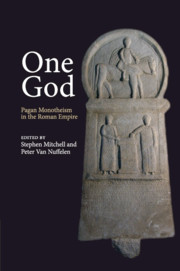Refine search
Actions for selected content:
23989 results in Ancient history
Frontmatter
-
- Book:
- Thucydides, Pericles, and Periclean Imperialism
- Published online:
- 06 July 2010
- Print publication:
- 31 May 2010, pp i-vi
-
- Chapter
- Export citation
Acknowledgments
-
- Book:
- Thucydides, Pericles, and Periclean Imperialism
- Published online:
- 06 July 2010
- Print publication:
- 31 May 2010, pp ix-x
-
- Chapter
- Export citation
Plate section
-
- Book:
- The Roman Wedding
- Published online:
- 05 June 2012
- Print publication:
- 24 May 2010, pp -
-
- Chapter
- Export citation
Frontmatter
-
- Book:
- The Roman Wedding
- Published online:
- 05 June 2012
- Print publication:
- 24 May 2010, pp i-vi
-
- Chapter
- Export citation
Contents
-
- Book:
- The Roman Wedding
- Published online:
- 05 June 2012
- Print publication:
- 24 May 2010, pp vii-x
-
- Chapter
- Export citation
Introduction
-
- Book:
- The Roman Wedding
- Published online:
- 05 June 2012
- Print publication:
- 24 May 2010, pp 1-14
-
- Chapter
- Export citation
Bibliography
-
- Book:
- The Roman Wedding
- Published online:
- 05 June 2012
- Print publication:
- 24 May 2010, pp 305-318
-
- Chapter
- Export citation
3 - To the Groom's House
-
- Book:
- The Roman Wedding
- Published online:
- 05 June 2012
- Print publication:
- 24 May 2010, pp 135-226
-
- Chapter
- Export citation
Acknowledgments
-
- Book:
- The Roman Wedding
- Published online:
- 05 June 2012
- Print publication:
- 24 May 2010, pp xi-xii
-
- Chapter
- Export citation
1 - The Laws of Humans and Gods
-
- Book:
- The Roman Wedding
- Published online:
- 05 June 2012
- Print publication:
- 24 May 2010, pp 15-60
-
- Chapter
- Export citation
Index
-
- Book:
- The Roman Wedding
- Published online:
- 05 June 2012
- Print publication:
- 24 May 2010, pp 319-341
-
- Chapter
- Export citation
4 - Gods of the Roman Wedding
-
- Book:
- The Roman Wedding
- Published online:
- 05 June 2012
- Print publication:
- 24 May 2010, pp 227-288
-
- Chapter
- Export citation
5 - Conclusion
-
- Book:
- The Roman Wedding
- Published online:
- 05 June 2012
- Print publication:
- 24 May 2010, pp 289-304
-
- Chapter
- Export citation
2 - At the House of the Bride
-
- Book:
- The Roman Wedding
- Published online:
- 05 June 2012
- Print publication:
- 24 May 2010, pp 61-134
-
- Chapter
- Export citation

One God
- Pagan Monotheism in the Roman Empire
-
- Published online:
- 20 May 2010
- Print publication:
- 29 April 2010
Frontmatter
-
- Book:
- Food and Identity in Early Rabbinic Judaism
- Published online:
- 06 July 2010
- Print publication:
- 17 May 2010, pp i-vi
-
- Chapter
- Export citation
Selected General Index
-
- Book:
- Food and Identity in Early Rabbinic Judaism
- Published online:
- 06 July 2010
- Print publication:
- 17 May 2010, pp 209-211
-
- Chapter
- Export citation
4 - Jewish Male Rabbinic Identity
-
- Book:
- Food and Identity in Early Rabbinic Judaism
- Published online:
- 06 July 2010
- Print publication:
- 17 May 2010, pp 138-184
-
- Chapter
- Export citation
Contents
-
- Book:
- Food and Identity in Early Rabbinic Judaism
- Published online:
- 06 July 2010
- Print publication:
- 17 May 2010, pp vii-viii
-
- Chapter
- Export citation
Conclusion
-
- Book:
- Food and Identity in Early Rabbinic Judaism
- Published online:
- 06 July 2010
- Print publication:
- 17 May 2010, pp 185-192
-
- Chapter
- Export citation
